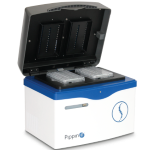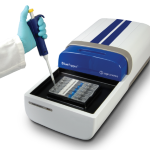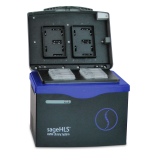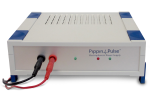Integrated analysis of miRNAs and mRNAs in thousands of single cells
January 2025
Authors:
Jia Li, Jing Tian, Tao Cai
Abstract:
“The simultaneous sequencing of multiple types of biomolecules can facilitate understanding various forms of regulation occurring in cells. Cosequencing of miRNA and mRNA at single-cell resolution is challenging, and to date, only a few such studies (examining a quite limited number of cells) have been reported. Here, we developed a parallel single-cell small RNA and mRNA coprofiling method (PSCSR-seq V2) that enables miRNA and mRNA coexpression analysis in many cells. The PSCSR-seq V2 method is highly sensitive for miRNA analysis, and it also provides rich mRNA information about the examined cells at the same time. We employed PSCSR-seq V2 to profile miRNA and mRNA in 2310 cultured cells, and detected an average of 181 miRNA species and 7354 mRNA species per cell. An integrated analysis of miRNA and mRNA profiles linked miRNA functions with the negative regulation of tumor suppressor and reprogramming of cellular metabolism. We coprofiled miRNA and mRNA in 9403 lung cells and generated a coexpression atlas for known cell populations in mouse lungs, and detected conserved expression patterns of miRNAs among lineage-related cells. Based on this information, we identified informative age-associated miRNAs in mouse and human lung cells including miR-29, which can be understood as a conserved marker for immunosenescence. PSCSR-seq V2 offers unique functionality to users conducting functional studies of miRNAs in clinical and basic biological research.”
Sage Science Products:
Pippin Prep
Methods Excerpt:
“Half of the PCR product was size selected for small RNA library collection using 3% agarose, dye-free, Pippin Prep (CDP3010, Sage Science) at 134–162 bp. The other half was purified with 2% Agarose, dye-free, Pippin Prep (CDF2010, Sage Science) at 270–650 bp to collect mRNA libraries.”
Author Affiliations:
National Institute of Biological Sciences, Beijing, China
Tsinghua Institute of Multidisciplinary Biomedical Research, Tsinghua, China
Nature Scientific Reports
DOI: 10.1038/s41598-025-85612-z
Leveraging the power of long reads for targeted sequencing
December 2024
Authors:
Shruti V. Iyer, Sara Goodwin, and William Richard McCombie
Abstract:
“Long-read sequencing technologies have improved the contiguity and, as a result, the quality of genome assemblies by generating reads long enough to span and resolve complex or repetitive regions of the genome. Several groups have shown the power of long reads in detecting thousands of genomic and epigenomic features that were previously missed by short-read sequencing approaches. While these studies demonstrate how long reads can help resolve repetitive and complex regions of the genome, they also highlight the throughput and coverage requirements needed to accurately resolve variant alleles across large populations using these platforms. At the time of this review, whole-genome long-read sequencing is more expensive than short-read sequencing on the highest throughput short-read instruments; thus, achieving sufficient coverage to detect low-frequency variants (such as somatic variation) in heterogenous samples remains challenging. Targeted sequencing, on the other hand, provides the depth necessary to detect these low-frequency variants in heterogeneous populations. Here, we review currently used and recently developed targeted sequencing strategies that leverage existing long-read technologies to increase the resolution with which we can look at nucleic acids in a variety of biological contexts.”
Sage Science Products:
BluePippin is indicated for the size selection hybridization-based PCR amplicons for PacBio sequencing. The SageHLS with the HLS-CATCH process is described for purifying HMW genomic targets.
Methods Excerpt:
Author Affiliations:
Cold Spring Harbor Laboratory, Cold Spring Harbor, NY.
Genome Research
Resolving the 22q11.2 deletion using CTLR-Seq reveals chromosomal rearrangement mechanisms and individual variance in breakpoints
July 2024
Authors:
Bo Zhou, Carolin Purmann, Hanmin Guo, GiWon Shin, Yiling Huang, Reenal Pattni, Qingxi Meng, Stephanie U. Greer, Tanmoy Roychowdhuryg, Raegan N. Wood, Marcus Ho, Heinrich zu Dohna, Alexej Abyzov, Joachim F. Hallmayer, Wing H. Wong, Hanlee P. Ji, and Alexander E. Urban
Abstract:
“We developed a generally applicable method, CRISPR/Cas9-targeted long-read sequencing (CTLR-Seq), to resolve, haplotype-specifically, the large and complex regions in the human genome that had been previously impenetrable to sequencing analysis, such as large segmental duplications (SegDups) and their associated genome rearrangements. CTLR-Seq combines in vitro Cas9-mediated cutting of the genome and pulse-field gel electrophoresis to isolate intact large (i.e., up to 2,000 kb) genomic regions that encompass previously unresolvable genomic sequences. These targets are then sequenced (amplification-free) at high on-target coverage using long-read sequencing, allowing for their complete sequence assembly. We applied CTLR-Seq to the SegDup-mediated rearrangements that constitute the boundaries of, and give rise to, the 22q11.2 Deletion Syndrome (22q11DS), the most common human microdeletion disorder. We then performed de novo assembly to resolve, at base-pair resolution, the full sequence rearrangements and exact chromosomal breakpoints of 22q11.2DS (including all common subtypes). Across multiple patients, we found a high degree of variability for both the rearranged SegDup sequences and the exact chromosomal breakpoint locations, which coincide with various transposons within the 22q11.2 SegDups, suggesting that 22q11DS can be driven by transposon-mediated genome recombination. Guided by CTLR-Seq results from two 22q11DS patients, we performed three-dimensional chromosomal folding analysis for the 22q11.2 SegDups from patient-derived neurons and astrocytes and found chromosome interactions anchored within the SegDups to be both cell type-specific and patient-specific. Lastly, we demonstrated that CTLR-Seq enables cell-type specific analysis of DNA methylation patterns within the deletion haplotype of 22q11DS.”
Sage Science Products:
SageHLS with the HLS-CATCH process for purifying HMW genomic targets.
Author Affiliations:
Department of Psychiatry and Behavioral Sciences, Stanford University School of Medicine, Stanford, CA Stanford Maternal and Child Health Research Institute, Stanford University School of Medicine, Stanford, CA
Department of Genetics, Stanford University School of Medicine, Stanford, CA
Department of Statistics, Stanford University, Stanford, CA
Department of Biomedical Data Science, Stanford University School of Medicine, Stanford, CA
Division of Oncology, Department of Medicine, Stanford University School of Medicine, Stanford, CA
Division of Computational Biology, Department of Quantitative Health Sciences, Mayo Clinic, Rochester, MN
Department of Biology, American University of Beirut, Lebanon
Program on Genetics of Brain Function, Stanford Center for Genomics and Personalized Medicine, Stanford University School of Medicine, Stanford, CA
CTLR-Seq Protocol
July 2024
Authors:
Bo Zhou, GiWon Shin,Yiling Huang, Raegan N. Wood, Hanlee P. Ji, Alexander E. Urban
Abstract:
“We developed a generally applicable method CRISPR/Cas9-targeted long read sequencing (CTLR-Seq) to resolve, haplotype-specifically, and at base-pair resolution, large, complex, and highly repetitive genomic regions that had been previously impenetrable to next-generation sequencing analysis, i.e. large segmental duplication (SegDup) regions and their associated genome rearrangements that often stretch hundreds of kilobases. CTLR-Seq combines in vitro Cas9-mediated cutting of the genome and pulse-field gel electrophoresis to haplotype-specifically isolate intact large (100-2000 kb) regions that encompass previously unresolvable genomic sequences. These targets are then sequenced (amplification-free) with up to 250x on-target coverage using nanopore sequencing, allowing for their complete sequence assembly.”
Sage Science Products:
SageHLS with the HLS-CATCH process for purifying HMW genomic targets.
Author Affiliations:
Department of Psychiatry and Behavioral Sciences and Department of Genetics, Stanford University School of Medicine, Stanford, CA
Stanford Child Health Research Institute, Stanford University School of Medicine, Stanford, CA
Division of Oncology, Department of Medicine, Stanford University School of Medicine, Stanford, CA
Protocols.io
DOI: 10.17504/protocols.io.q26g71d7kgwz/v1
Processing frozen archival human DNA samples for large-scale SQK-LSK114 Oxford Nanopore long-read DNA sequencing SOP v1
June 2024
Authors:
Alicia Wenghöfer, Kimberly Paquette, Laksh Malik, Breeana Baker, Cedric Kouam, Kimberley J Billingsley
Abstract:
“As part of the GP2 monogenic network we will generate long-read sequencing data to better understand the genetic architecture of Parkinson’s disease. To generate this large-scale Nanopore data we have developed a protocol for processing and long-read sequencing frozen human DNA samples, ideally targeting an N50 of ~30kb and ~30X coverage. However, with archival human DNA samples, we usually see a drop in DNA quality in terms of DNA length. Therefore, this protocol is focused on attempting to achieve the highest N50 and coverage possible from the input available.“
Sage Science Products:
BluePippin with High-Pass Plus gel cassettes, >10kb High-Pass protocol.
Author Affiliations:
Center for Alzheimer’s and Related Dementias, National Institute on Aging, Bethesda, Maryland
Institute of Neurogenetics, University Hospital Schleswig-Holstein, Luebeck, Germany
Laboratory of Neurogenetics, National Institute on Aging, Bethesda, Maryland
Protocols.io
DOI: 10.17504/protocols.io.5jyl82morl2w/v1





